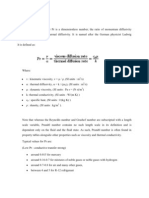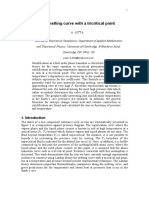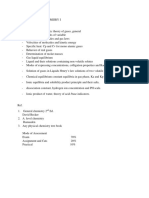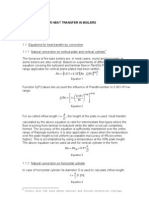Prandtl Number
Prandtl Number
Uploaded by
joh aseerkCopyright:
Available Formats
Prandtl Number
Prandtl Number
Uploaded by
joh aseerkOriginal Description:
Copyright
Available Formats
Share this document
Did you find this document useful?
Is this content inappropriate?
Copyright:
Available Formats
Prandtl Number
Prandtl Number
Uploaded by
joh aseerkCopyright:
Available Formats
Prandtl number
From Wikipedia, the free encyclopedia
Jump to navigation
Jump to search
This article has multiple issues. Please help improve it or discuss these issues on
the talk page. (Learn how and when to remove these template messages)
This article includes a list of references, but its sources remain unclear because
it has insufficient inline citations. (August 2014)
This article needs additional citations for verification. (August 2014)
The Prandtl number (Pr) or Prandtl group is a dimensionless number, named after the
German physicist Ludwig Prandtl, defined as the ratio of momentum diffusivity to
thermal diffusivity.[1] That is, the Prandtl number is given as:
P r = ? a = momentum diffusivity thermal diffusivity = � / ? k / ( c p ? ) = c
p � k {\displaystyle \mathrm {Pr} ={\frac {\nu }{\alpha }}={\frac {\mbox{momentum
diffusivity}}{\mbox{thermal diffusivity}}}={\frac {\mu /\rho }{k/
(c_{p}\rho )}}={\frac {c_{p}\mu }{k}}} {\displaystyle \mathrm {Pr} ={\frac {\nu }
{\alpha }}={\frac {\mbox{momentum diffusivity}}{\mbox{thermal diffusivity}}}={\frac
{\mu /\rho }{k/(c_{p}\rho )}}={\frac {c_{p}\mu }{k}}}
where:
? {\displaystyle \nu } \nu : momentum diffusivity (kinematic viscosity), ? = �
/ ? {\displaystyle \nu =\mu /\rho } \nu =\mu /\rho , (SI units: m2/s)
a {\displaystyle \alpha } \alpha : thermal diffusivity, a = k / ( ? c p )
{\displaystyle \alpha =k/(\rho c_{p})} \alpha =k/(\rho c_{p}), (SI units: m2/s)
� {\displaystyle \mu } \mu : dynamic viscosity, (SI units: Pa s = N s/m2)
k {\displaystyle k} k : thermal conductivity, (SI units: W/m-K)
c p {\displaystyle c_{p}} c_{p} : specific heat, (SI units: J/kg-K)
? {\displaystyle \rho } \rho : density, (SI units: kg/m3).
Note that whereas the Reynolds number and Grashof number are subscripted with a
length scale variable, the Prandtl number contains no such length scale in its
definition and is dependent only on the fluid and the fluid state. As such, the
Prandtl number is often found in property tables alongside other properties such as
viscosity and thermal conductivity.
For most gases over a wide range of temperature and pressure, Pr is approximately
constant. Therefore, it can be used to determine the thermal conductivity of gases
at high temperatures, where it is difficult to measure experimentally due to the
formation of convection currents.[1]
Typical values for Pr are:
0.003 for molten potassium at 975 K[1]
around 0.015 for mercury
0.065 for molten lithium at 975 K[1]
around 0.16-0.7 for mixtures of noble gases or noble gases with hydrogen
0.63 for oxygen[1]
around 0.71 for air and many other gases
1.38 for gaseous ammonia[1]
between 4 and 5 for R-12 refrigerant
around 7.56 for water (At 18 �C)
13.4 and 7.2 for seawater (At 0 �C and 20 �C respectively)
50 for n-butanol[1]
between 100 and 40,000 for engine oil
1000 for glycerol[1]
10,000 for polymer melts[1]
around 1�1025 for Earth's mantle.
Small values of the Prandtl number, Pr << 1, means the thermal diffusivity
dominates. Whereas with large values, Pr >> 1, the momentum diffusivity dominates
the behavior. For example, the listed value for liquid mercury indicates that the
heat conduction is more significant compared to convection, so thermal diffusivity
is dominant. However, for engine oil, convection is very effective in transferring
energy from an area in comparison to pure conduction, so momentum diffusivity is
dominant.[2]
The Prandtl numbers of gases are about 1, which indicates that both momentum and
heat dissipate through the fluid at about the same rate. Heat diffuses very quickly
in liquid metals (Pr<<1) and very slowly in oils (Pr>>1) relative to momentum.
Consequently thermal boundary layer is much thicker for liquid metals and much
thinner for oils relative to velocity boundary layer.
In heat transfer problems, the Prandtl number controls the relative thickness of
the momentum and thermal boundary layers. When Pr is small, it means that the heat
diffuses quickly compared to the velocity (momentum). This means that for liquid
metals the thickness of the thermal boundary layer is much bigger than the velocity
boundary layer.
The mass transfer analog of the Prandtl number is the Schmidt number.
You might also like
- CPE533 Shell and Tube Heat Exchanger Full Lab ReportDocument32 pagesCPE533 Shell and Tube Heat Exchanger Full Lab ReportFazsroul89% (44)
- A New Heat Transfer Correlation For Transition and Turbulent Fluid Flow in TubesDocument15 pagesA New Heat Transfer Correlation For Transition and Turbulent Fluid Flow in TubesAlexander LopezNo ratings yet
- Chemical Injection Pump - Operating ManualDocument19 pagesChemical Injection Pump - Operating ManualSamuel Onyewuenyi100% (2)
- Chemsheets A2 1001 Kinetics BookletDocument20 pagesChemsheets A2 1001 Kinetics BookletMarc WilfordNo ratings yet
- Prandtl NumberDocument2 pagesPrandtl NumberSudhy SjNo ratings yet
- It Is Defined As:: Dimensionless Number Kinematic Viscosity Thermal Diffusivity Ludwig PrandtlDocument7 pagesIt Is Defined As:: Dimensionless Number Kinematic Viscosity Thermal Diffusivity Ludwig PrandtlSreehari RavindranNo ratings yet
- Heat Transfer Modes ConvectionDocument4 pagesHeat Transfer Modes ConvectionMark Angelo UyNo ratings yet
- Droplet Vaporization Model For Spray Combustion CalculationsDocument14 pagesDroplet Vaporization Model For Spray Combustion CalculationsJose Manuel Tejera GonzalvezNo ratings yet
- 1997 - Nowak - Kleinrahm - Wagner - Measur and Correl of PRoT Rel of Nitrogen in Homogen Gas and Liquid Regions at 66 - 340 K and Press Up To 12 MPaDocument20 pages1997 - Nowak - Kleinrahm - Wagner - Measur and Correl of PRoT Rel of Nitrogen in Homogen Gas and Liquid Regions at 66 - 340 K and Press Up To 12 MPaAlexanderNo ratings yet
- HE TheoryDocument6 pagesHE TheoryAnonymous Xf4w0D2cNo ratings yet
- Research_of_Combustion_Process_of_Combustible_MixturesDocument7 pagesResearch_of_Combustion_Process_of_Combustible_Mixtureslafimahafza2002No ratings yet
- 179a PDFDocument7 pages179a PDFIndra YugiNo ratings yet
- 1 s2.0 S0022407303002681 MainDocument14 pages1 s2.0 S0022407303002681 MainDuvalNo ratings yet
- Report On Heat TransferDocument11 pagesReport On Heat TransferArbind BokadeNo ratings yet
- Dimensionless Numbers in Heat TansferDocument2 pagesDimensionless Numbers in Heat TansferChirag DaveNo ratings yet
- Energies 12 03266Document14 pagesEnergies 12 03266BillyNo ratings yet
- Tube Banks Single-Phase Heat Transfer inDocument22 pagesTube Banks Single-Phase Heat Transfer inarif aktaşNo ratings yet
- Forced ConvectionDocument16 pagesForced ConvectionAleem AhmedNo ratings yet
- Ideal Gas LawDocument4 pagesIdeal Gas LawAbdul RaufNo ratings yet
- Vikash Babu Fundamentals of Gas Dynamic-15-24Document10 pagesVikash Babu Fundamentals of Gas Dynamic-15-24عمر ربيع المحلاوىNo ratings yet
- Fluid-Friction HT AnalogyDocument16 pagesFluid-Friction HT Analogybasit.000No ratings yet
- Anneli Aitta 2006, "Iron Melting Curve With A Tricritical Point", Journal of Statistical MechanicsDocument17 pagesAnneli Aitta 2006, "Iron Melting Curve With A Tricritical Point", Journal of Statistical MechanicsNguyen Tri NguyenNo ratings yet
- Heat Transfer: Characteristic NumbersDocument7 pagesHeat Transfer: Characteristic NumbersVeronica ChuNo ratings yet
- 5a. Mass Transfer CoeffDocument5 pages5a. Mass Transfer Coeffmunazzil.cscNo ratings yet
- SCH 103 NotesDocument50 pagesSCH 103 NotesJacqueseNo ratings yet
- Heat Transfer of Fluids Inside PipesDocument25 pagesHeat Transfer of Fluids Inside Pipesbronxtoles4ever100% (1)
- CM5 L2 S4 MecafluxDocument14 pagesCM5 L2 S4 MecafluxCəvahir AğazadəNo ratings yet
- A Quick Guide To Dimensional Analysis: Adam Powell June 19, 2007Document5 pagesA Quick Guide To Dimensional Analysis: Adam Powell June 19, 2007againNo ratings yet
- Van Der Waal's EquationDocument7 pagesVan Der Waal's EquationRosse KNo ratings yet
- Equations For Heat Transfer in BoilersDocument9 pagesEquations For Heat Transfer in BoilersamitdharneNo ratings yet
- Value of Universal Gas Constant: FormulaDocument2 pagesValue of Universal Gas Constant: Formulastructuredes.1No ratings yet
- Heat Transfer On A Laminar Bingham Plastic (Yield Power Law) Fluids Over A Circular TubeDocument9 pagesHeat Transfer On A Laminar Bingham Plastic (Yield Power Law) Fluids Over A Circular TubeAbu Bundin As-SolowiNo ratings yet
- Mass Transfer Coefficient: Experiment No.-5 (A)Document5 pagesMass Transfer Coefficient: Experiment No.-5 (A)Harsh DuttaNo ratings yet
- Thermodynamics For Beginners - Chapter 5 WORKING WITH IDEAL GASDocument35 pagesThermodynamics For Beginners - Chapter 5 WORKING WITH IDEAL GASDudu MamanNo ratings yet
- HE TheoryDocument6 pagesHE TheoryMutiaRezaNo ratings yet
- Dimension Less Numbers in Heat TransferDocument7 pagesDimension Less Numbers in Heat TransferRajkumar MeenaNo ratings yet
- 5 - Real-Gas Aerothermodynamic PhenomenaDocument2 pages5 - Real-Gas Aerothermodynamic Phenomenaambeth kathirkamanNo ratings yet
- HW2Document2 pagesHW2diptaparna100% (1)
- Thermal Considerations in Pipe FlowsDocument11 pagesThermal Considerations in Pipe FlowsWaqas AhmadNo ratings yet
- IPUE 208 (Jan-April) : Introduction To Process and Utilities EngineeringDocument29 pagesIPUE 208 (Jan-April) : Introduction To Process and Utilities EngineeringRandy SooknananNo ratings yet
- 1. Units Relevant to Steam EngineeringDocument13 pages1. Units Relevant to Steam Engineeringresky sepadanNo ratings yet
- Perpindahan Panas IIIDocument15 pagesPerpindahan Panas IIIAmanda WillisNo ratings yet
- Relaciones Numero PRDocument13 pagesRelaciones Numero PREduardo Badiel LizcanoNo ratings yet
- High Reynolds Number Computation For Turbulent Heat Transfer in A Pipe FlowDocument10 pagesHigh Reynolds Number Computation For Turbulent Heat Transfer in A Pipe Flowkaizhen shiNo ratings yet
- Thermal Conductivity Prandtl NumberDocument2 pagesThermal Conductivity Prandtl NumberRoberto BeltNo ratings yet
- Lecture 3Document46 pagesLecture 3CHOWDHURY SAMINo ratings yet
- Importance of Dimensionless Numbers in Mass TransferDocument27 pagesImportance of Dimensionless Numbers in Mass TransferAli AmmarNo ratings yet
- ANALOGYDocument1 pageANALOGYaathiraNo ratings yet
- SCHX1014 - Chemical Engineering Thermodynamics - Unit 3Document17 pagesSCHX1014 - Chemical Engineering Thermodynamics - Unit 3Shanmuga PriyaNo ratings yet
- Cyclic Simulation of Stirling CoolerDocument7 pagesCyclic Simulation of Stirling CoolerCHAUHAN MAXIME SVNITNo ratings yet
- CPE533 Shell and Tube Heat Exchanger Full Lab ReportDocument28 pagesCPE533 Shell and Tube Heat Exchanger Full Lab ReportJonnah Faye MojaresNo ratings yet
- Lab ReportDocument16 pagesLab ReportSandra Enn Bahinting100% (1)
- Thermal and Concentration Boundary LayersDocument5 pagesThermal and Concentration Boundary LayersRosalyne Artho-PhanNo ratings yet
- Heat Transfer in Rough TubesDocument3 pagesHeat Transfer in Rough TubesChirag BalarNo ratings yet
- List of ContentDocument5 pagesList of Contenthassanmasud hassanNo ratings yet
- Activity Thermo - PESIDASDocument2 pagesActivity Thermo - PESIDASRaymund PesidasNo ratings yet
- FM Mod 5Document37 pagesFM Mod 5manoj kumar jainNo ratings yet
- Gas Laws: Boyle's Law or The Pressure-Volume Law States That The Volume of A Given AmountDocument9 pagesGas Laws: Boyle's Law or The Pressure-Volume Law States That The Volume of A Given AmountArun KarthikeyanNo ratings yet
- Gas Hydrates 1: Fundamentals, Characterization and ModelingFrom EverandGas Hydrates 1: Fundamentals, Characterization and ModelingDaniel BrosetaNo ratings yet
- Design of Pro. WTP (6.8 MLD) For BasavkalyanDocument27 pagesDesign of Pro. WTP (6.8 MLD) For BasavkalyanPradeep Kumar Sharma100% (1)
- HTTP WWW Red Bag Com Engineering Guides 581 BN Eg k3 Standard Method For Control Valve Calculations HTMLDocument4 pagesHTTP WWW Red Bag Com Engineering Guides 581 BN Eg k3 Standard Method For Control Valve Calculations HTMLmashudi_fikriNo ratings yet
- Introduction To UTCHEM, An In-House Chemcial Simulator: February 2015Document32 pagesIntroduction To UTCHEM, An In-House Chemcial Simulator: February 2015Helton MagnoNo ratings yet
- Cryo CarDocument18 pagesCryo CaravikashNo ratings yet
- CVC AlcsDocument10 pagesCVC Alcsmanoj_amritkarNo ratings yet
- Aging IadaDocument60 pagesAging IadaJunaidah MohdnoorNo ratings yet
- Calculation of Pipe Reinforcement ASME B31.3Document9 pagesCalculation of Pipe Reinforcement ASME B31.3yhnsharma80% (5)
- Thermodynamics Problem Based Learning Group Report. Rankine CycleDocument17 pagesThermodynamics Problem Based Learning Group Report. Rankine CycleRafael DamarNo ratings yet
- Characteristic Features of Common Fluid Machines: Objective: Is To Transfer To A Flow MediumDocument26 pagesCharacteristic Features of Common Fluid Machines: Objective: Is To Transfer To A Flow MediumYohannes EndaleNo ratings yet
- 355 01 Water PipeDocument14 pages355 01 Water Pipeben vervuurtNo ratings yet
- Pipelines Process PipingDocument16 pagesPipelines Process PipingmariomatoNo ratings yet
- Importance of Supercritical Fluid Extraction Techniques in Pharmaceutical Industry - A ReviewDocument17 pagesImportance of Supercritical Fluid Extraction Techniques in Pharmaceutical Industry - A Reviewbillearl7635No ratings yet
- Well Stimulation 01Document20 pagesWell Stimulation 01Romadona Yoga PutratamaNo ratings yet
- Data SHEET SEPARADOR 3Document1 pageData SHEET SEPARADOR 3Diego RuanoNo ratings yet
- Siddharth Patel (UC3212)Document4 pagesSiddharth Patel (UC3212)Arzoo ChaudhariNo ratings yet
- 355GF Data Sheet US - MetricDocument2 pages355GF Data Sheet US - Metricminov minovitchNo ratings yet
- Perhitungan Efisiensi Boiler ȠboilerDocument3 pagesPerhitungan Efisiensi Boiler ȠboilerStrngr XtupidNo ratings yet
- Module 3 Hydro 2Document13 pagesModule 3 Hydro 2Ghea SafiloNo ratings yet
- Grade 7 Science: SolutionsDocument32 pagesGrade 7 Science: SolutionsMargareth Rivera100% (1)
- Modeling Reactions On Uniform SurfacesDocument27 pagesModeling Reactions On Uniform Surfacescebajamundi100% (4)
- Fluid Mechanics: MEHD 224Document11 pagesFluid Mechanics: MEHD 224anis suhailiNo ratings yet
- Polymers 14 00274Document28 pagesPolymers 14 00274MECHANICAL SHORTS Gate Technical ExamNo ratings yet
- Calculation Dilute Phase Pressure Drop Zenz Othmer MethodDocument8 pagesCalculation Dilute Phase Pressure Drop Zenz Othmer MethodGeorgi Mitkov SavovNo ratings yet
- Te 2 SyllabusDocument3 pagesTe 2 SyllabusPolireddi Gopala KrishnaNo ratings yet
- Datasheet ClarifierDocument1 pageDatasheet ClarifierMuhammad GhaziNo ratings yet
- HD Water Treatment MethodsDocument3 pagesHD Water Treatment Methodsnermeen ahmedNo ratings yet
- 2.1. Flash Equilibrium (Isothermal)Document12 pages2.1. Flash Equilibrium (Isothermal)Hien Ngo ThiNo ratings yet
- Chapter 10. 10.1. 10.2. 10.3.Document59 pagesChapter 10. 10.1. 10.2. 10.3.OmarhersanNo ratings yet

























































































